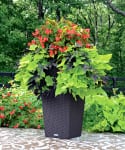Container Gardens that Even You Can’t Kill!
By Pamela Crawford
Pamela has pioneered in finding out which plants are really easy to use. Her work has spanned 20 years and tens of thousands of container plants. In this video, she shares some examples of container gardens that even you can’t kill!
Here are some tips for easy container gardens from her book, ‘Easy Contianer Gardens:”
1. Buy the wrong plants.
Most beginners buy plants that don’t meet their expectations simply because they don’t understand the plant’s flowering habits – or that the plant is an erratic performer.
Take this book with you to your garden center. If you stick to the blue ribbon plants described on pages eight to eleven (and shown in chapter 9), you will have a great chance of success with tough plants that bloom for all or most of your growing season.
See pages 20-24 for tips on how to buy other plants at your local garden center.
2. Buy the wrong potting mix
Don’t skimp on your potting mix. Good potting mix costs a little bit more but makes all the difference. The plants grow larger and live longer with quality potting mix. Do not buy topsoil, garden soil, or potting soil for containers. It is too heavy, and the plants may rot and die quickly.
Look for a brand name you trust. Peters, Miracle Grow, Lambert’s and Fafard (along with many others) offer top-quality potting mix.
3. Buy the wrong fertilizer
I have killed plants by using fertilizers several times. My first lawn died from over fertilization. Years later, an entire garden my landscaping company planted died because the popular, slow-release fertilizer we used released all three month’s worth of nutrients at once. Water causes the fertilizer to activate, and we had a lot of rain. I don’t want to kill plants because of such a routine occurrence!
So, I kept using new products. A fertilizer salesman gave me some samples of a new fertilizer that was supposed to be perfect for the flowers I was growing in my nursery. Luckily, I had the sense to test it on about 25 plants before I tried it on thousands. All 25 plants were dead within a week!
Liquid fertilizers (the blue powder you mix with water in a hose sprayer and spray on your plants) is supposed to be the mildest product on the market. A good friend of mine burned up about half her garden with that product.
But, there is good news! I finally found a product made that not only didn’t kill my plants but also made them look like a magazine cover, I got so excited about it that I put my name on it. See more about fertilizer on page 46.
4. Water Incorrectly
Like people, plants need water to live. However, if you give plants too much, they die from drowning. If you give them too little, they die of thirst.
Luckily, knowing when and how much to water is quite easy. See pages 48-51 for this information.
5. Pile Potting Mix Around the Stem of the Plant
If potting mix or organic mulch comes into contact with the stem of many plants, the stem rots, killing the plant. It is quite easy to avoid this plight by simply planting the plants a little higher, as shown in the drawing.
To help retain water, some people like to put organic mulch on top of the potting mix after they have planted a container. This method works fine on large plants, like azaleas or ti plants, provided you don’t pile the mulch up around the stem. However, on small annuals, like impatiens, it is quite difficult to mulch without harming the plant.
6. Plant in a Pot Without Holes in the Bottom
If your pots don’t have holes in the bottom for drainage, the plants will die (unless the pot is specially designed for self watering). See page 38 to learn how to drill holes in the bottoms of pots.
Luckily, most pots come with holes in the bottom. If you see one you want to buy that doesn’t have holes, ask the salesperson if she will drill them for you. Many garden centers offer that service.
7. Plant in the Wrong Amount of Light
Different plants need different amounts of light. A petunia (shown) likes sun, while a dieffenbachia likes shade. But how much sun is enough for sun plants? The rule of thumb is at least four to six hours of direct sun a day. In other words, if your petunia just gets two hours of sun with shade the rest of the day, it will not do well.
For your shade-only plants, if they are left in the sun, the leaves and flowers will burn. Of the two, shade plants are more complicated to place than sun plants. See pages 34-35 for more information on shade gardening.
Pamela Crawford designs gardens in Palm Beach County, Florida. This video is appropriate throughout Pamela’s service area, including Boca Raton landscapes, town of Palm Beach landscapes, Palm Beach Gardens landscapes, Jupiter landscapes, and Wellington landscapes.
This article is taken from Easy Container Gardens, Copyright ©2008, Color Garden, Inc.
All rights reserved. No part of this publication may be reproduced or transmitted in any form or by any means, electronic or mechanical, including photocopy, recording, or any other information storage and retrieval system (including anywhere on the web) without prior permission in writing from the publisher.
Published by Color Garden, Inc.,





